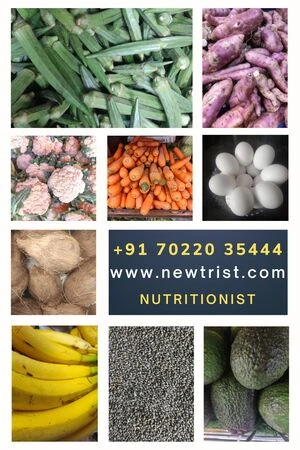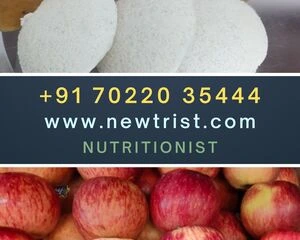Newtrist Nutritionist Bullous Pemphigoid Diet Plan consists of soft foods such as blended soups, mashed foods, puddings, and boiled vegetable purees.
- Early morning drink @ 6:30 am: Tender coconut water
- Breakfast @ 9 am: Oatmeal with cooked banana
- Mid-morning meal @ 11 am: Pureed vegetable soup
- Lunch @ 1 pm: Soft-cooked rice with curd and boiled egg
- Evening snack @ 4 pm: Chia seed pudding with coconut milk
- Dinner @ 7 pm: Idly with less spicy sambar and soft-boiled vegetables
Consult 19 years experienced Chief Nutritionist Vasanthi for expert advice and a personalized diet plan. In-person consultation at HSR, Koramangala, Bellandur, Haralur, and video consultation across India.
- Consultation INR 750
- 1 Week personalized diet plan INR 2000
- 1 Month personalized diet plan INR 4000
- 3 Months personalized diet plan INR 9000

Table of Contents
What is Bullous Pemphigoid?
Bullous Pemphigoid is a rare autoimmune condition characterized by hive-like welts and fluid-filled blisters. It is a non-contagious disease that is common in men and women over 60 years of age. It is commonly seen in the mouth, arms, legs, abdomen, and groin regions.
This disease occurs when the body’s immune system affects the tissues on the outer surface of the skin. It may not be painful but irritation and painful sore may persist due to the break-open of the blisters.
Blisters are usually found in between the creases of the skin. A clear fluid may ooze out of the blisters which may sometimes contain a few droplets of blood. A person is more prone to acquire the disease if he/she has multiple sclerosis, epilepsy, dementia, Parkinson’s disease, and stroke. This disease may be fatal in case of infection of the blisters and poor hygienic conditions.
The primary cause of the disease is unknown. UV rays from the sun and ionizing radiation may aggravate the condition. Bullous Pemphigoid goes away on its own and in some cases, it can be treated with the intake of corticosteroids, topical creams, and ointments.
What are the symptoms of Bullous Pemphigoid?
The symptoms of Bullous Pemphigoid are
Itching may occur before certain weeks of the formation of blisters. Treatments involve the use of antibiotics and ointments that heals the blisters and ease the itching. Psoriasis, multiple sclerosis, ulcers, rheumatoid arthritis, and diabetes may trigger the condition and the UV light therapy used for treatment may irritate the affected skin.
When there is a flare-up of symptoms with the intake of certain foods, eliminate them from the diet and observe for the improvement of the symptoms.
A dermatologist may diagnose Bullous Pemphigoid with the help of blood tests and skin biopsy.
What are the stages of Bullous Pemphigoid?
Bullous Pemphigoid can start with itchiness and the formation of raised bumps in its initial stages. The bumps later transform into fluid-filled blisters which may contain blood in some cases. Bullous Pemphigoid may take as long as 5 years to get rid of completely, whereas, it may cause serious problems in old age people and people with poor health.
Bullous Pemphigoid Diet Plan
The Bullous Pemphigoid diet plan consists of soft, non-spicy foods that are easy to digest. A healthy meal plan with nutrient-dense foods prevents deficiency of nutrients and helps in the effective management of the symptoms.
- Early morning drink @ 6:30 am: Diluted carrot juice
- Breakfast @ 9 am: Scrambled eggs and sliced avocados
- Mid-morning meal @ 11 am: Shredded chicken soup
- Lunch @ 1 pm: Dal khichdi with soft-cooked vegetables and applesauce
- Evening snack @ 4 pm: Mashed sweet potatoes and boiled egg
- Dinner @ 7 pm: Fluffy dosa with coconut chutney

Foods to avoid with Bullous Pemphigoid
Foods to avoid with Bullous Pemphigoid are
- Raw vegetables
- Tomatoes
- Garlic
- Onions
- Horseradish
- Bell peppers
- Citrus fruits
- Dry fruits
- Crusty bread
- Chips and crackers
- French fries
- Popcorn
- Fried foods
- Spicy foods
- Hot beverages
- Chunky Peanut butter
- Pickles
- Pizza
- Sauces
- Chocolates.
Choose healthy options that are rich in nutrients to boost your overall health. Substitute herbs instead of chilies and pepper to make the food palatable. Focus on protein-rich sources to improve stamina and recover from infections.
Consuming foods in hot conditions may hurt the infected areas. Wait for the food to cool down a little bit and have it.
Refrain from drinking citrus fruit juice like orange juice, which will irritate your sores and cause new sores. Maintaining good oral hygiene can aid in the improvement of the symptoms.
Best vegetables for Bullous Pemphigoid
Some of the best vegetables for Bullous Pemphigoid are
- Carrot
- Beetroot
- Cauliflower
- Ladies finger
- Pumpkin
- Bottle gourd
- Mushrooms.
Best fruits for Bullous Pemphigoid
Here are some of the best fruits for Bullous Pemphigoid
- Apples
- Bananas
- Avocados
- Custard apple
- Pomegranate
- Honeydew melon
- Litchi
- Apricots
- Mangoes
- Papaya
- Ice apples
- Coconuts
Fruits are excellent sources of vitamins, minerals, and antioxidants. Eating fruits reduces the inflammatory reaction of the blister formation, provides energy to fight fatigue, and reduces the appetite for sweets and junk foods. The fiber content of fruits keeps you fuller for longer periods.
Avoid the consumption of citrus fruits that are acidic such as lemons, sweet limes, oranges, kiwis, grapes, and strawberries as the citric acid in these fruits may irritate the blisters in the mouth.
Tips for Bullous Pemphigoid
Below are some useful tips for Bullous Pemphigoid

- Take care of your skin. Clean the blisters with mild soap (neutral pH) and clean water and pat dry the skin with a clean soft towel/cloth. Apply antibiotic creams or ointments as per the doctor’s advice.
- Reduce your activity time. Blisters on the hands and feet may cause difficulties in walking and doing other daily activities.
- Wear loose dresses made of pure cotton and other soft material that does not irritate the skin.
- Avoid too much exposure to the sun as prolonged exposure may cause irritation of the affected areas and the UV rays from the sun may aggravate the disease.
- Mind your food intake. People with blisters in the mouth should refrain from eating hard and crispy foods, spicy foods, raw vegetables, citrus fruits, and hot tea/coffee which might cause exacerbation of the symptoms.
- Be cautious not to injure your skin as injuries can cause new blisters to form.
- Popping the blisters is not advised until your dermatologist recommends it. If done, the utmost care and safety precautions have to be followed to prevent infections.
- Book an appointment with our expert nutritionists to obtain a clear view of the foods to eat and those to avoid.
Foods to prevent Bullous Pemphigoid
There is no specific diet or food that can prevent Bullous Pemphigoid. It is an autoimmune disease that occurs as a result of the body’s immune system affecting the body’s cells. Avoiding exposure to sunlight can prevent the triggering of the symptoms.
Avoiding acidic fruits and hard foods in the diet helps to prevent irritation of the mouth sores and small blisters. Lesions in the mouth may be painful and cause difficulty when eating. This leads to nutritional deficiencies, weight loss, and depletion of protein stores and calcium from the body.
Prepare a food journal of the daily foods you eat and observe the symptoms. You may find remission and trigger of the symptoms with specific foods. For example, you may notice the appearance or worsening of the lesions with the intake of onions and garlic in the diet. Elimination of such foods can help to relieve the symptoms.
Consume a variety of foods that are soft-cooked, mashed, blended, and pureed into smoothies to prevent malnutrition. Cook the vegetables until tender and soft. Try to eat small meals at frequent intervals rather than large meals one at a time. Consume diluted unsweetened fruit juices in between meals.
Consume protein-rich foods such as chicken in its minced or shredded form. Avoid adding too many spices to fish while cooking. Scrambled eggs, poached eggs, omelets, and cottage cheese offer a good protein source.
Bullous Pemphigoid FAQs
What are the best foods to eat for Bullous Pemphigoid?
Bullous Pemphigoid in the mouth requires soft and bland foods that are easy to swallow and don’t hurt your blisters. Custard, puddings, applesauce, steamed foods, mashed vegetables, soft-cooked vegetables, blended soups, and oatmeal are some of the best foods for Bullous Pemphigoid.
It is advised to stay away from inflammatory foods such as processed meats, packaged foods, fried foods, refined foods, and foods high in saturated fats.
What is the natural remedy for Bullous Pemphigoid?
Taking care of the wounds and blisters, limiting activities such as walking and carrying out daily chores if the disease is found on arms and feet, wearing soft loose-fitting clothes made of pure cotton, and avoiding too much exposure to the sun’s rays are some of the ways to lower the exacerbation of the symptoms of Bullous Pemphigoid.
How can I reduce Bullous Pemphigoid?
Bullous Pemphigoid can be reduced by consuming a diet rich in anti-inflammatory foods, and devoid of citrus fruits, hot beverages, and spicy foods.
Are vitamins and calcium good for Bullous Pemphigoid?
Vitamin D is essential for Pemphigoid patients as the lack of this vitamin and intake of certain supplements can deplete the absorption of vitamin D.
Calcium and iron are some of the crucial minerals required for the prevention of osteoporosis and fatigue that may result due to this condition.
What are the first signs of Bullous Pemphigoid?
Itchy skin, raised bumps, large blisters filled with fluid or pus, darkening of the skin surrounding the blisters, hive-like rash, mouth sores, and small blisters of the mucous membranes are a few first signs of Bullous Pemphigoid. Excessive exposure to the UV rays of the sun may trigger the condition.
Is Bullous Pemphigoid a serious condition?
Bullous Pemphigoid may be a serious condition if untreated. The disease can be fatal in patients with a weak immune system and poor health. The blisters may penetrate deeper into the skin and spread to your bloodstream (sepsis) if the symptoms are ignored.
Proper hygiene and care can help you get rid of the sores and blisters in a shorter duration. Painful mouth sores can alter your food intake and cause deficiencies in vital nutrients.